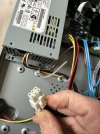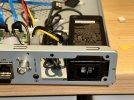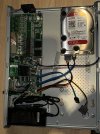Hi. I read another thread on reducing fan noise on DS-7608NI-I2/8P and wanted to share some findings concerning POWER reduction as well as noise. Since the NVR is on 24/7 this is important to me.
In my installation, I do not use the PoE since cameras are on my main LAN and powered from a switch. With one HDD installed (WD red) I measure approx 19W mains power consumption. I have found that the unit runs perfectly happily with the internal 52V supply disconnected from the board and this reduces the power draw by approx 1.5W to 17.4W. Note, I already disconnected the 40mm case fan since this seems primarily intended to cool the POE components.
Using a clamp meter, I measure approx 890mA DC taken from the 12V rail. So, approx 10.7W only. On these numbers, it seems that the built in PSU (delta dps-200pb) is fairly inefficient in converting 230V to 12V at such a low current (approx 60%). So I am interested in replacing this unit with a silent fanless brick such as Meanwell GST60A12-P1J. This has a typical efficiency of 89% so potentially could save in the region of 5W and at the same time make the box silent (other than the HDD). 5W may not be much but it's 3.6kWh (about £1 at time of writing) per month.
Does anybody know the spec of the 6-pin power connector which carries the 12VDC from the PSU to the PCB? Based on googling it looks rather like a PCIE GPU power connector but not quite the same. I'd prefer not to cut the existing cable from the PSU and make an adaptor cable to the new power brick...
Thanks
In my installation, I do not use the PoE since cameras are on my main LAN and powered from a switch. With one HDD installed (WD red) I measure approx 19W mains power consumption. I have found that the unit runs perfectly happily with the internal 52V supply disconnected from the board and this reduces the power draw by approx 1.5W to 17.4W. Note, I already disconnected the 40mm case fan since this seems primarily intended to cool the POE components.
Using a clamp meter, I measure approx 890mA DC taken from the 12V rail. So, approx 10.7W only. On these numbers, it seems that the built in PSU (delta dps-200pb) is fairly inefficient in converting 230V to 12V at such a low current (approx 60%). So I am interested in replacing this unit with a silent fanless brick such as Meanwell GST60A12-P1J. This has a typical efficiency of 89% so potentially could save in the region of 5W and at the same time make the box silent (other than the HDD). 5W may not be much but it's 3.6kWh (about £1 at time of writing) per month.
Does anybody know the spec of the 6-pin power connector which carries the 12VDC from the PSU to the PCB? Based on googling it looks rather like a PCIE GPU power connector but not quite the same. I'd prefer not to cut the existing cable from the PSU and make an adaptor cable to the new power brick...
Thanks




